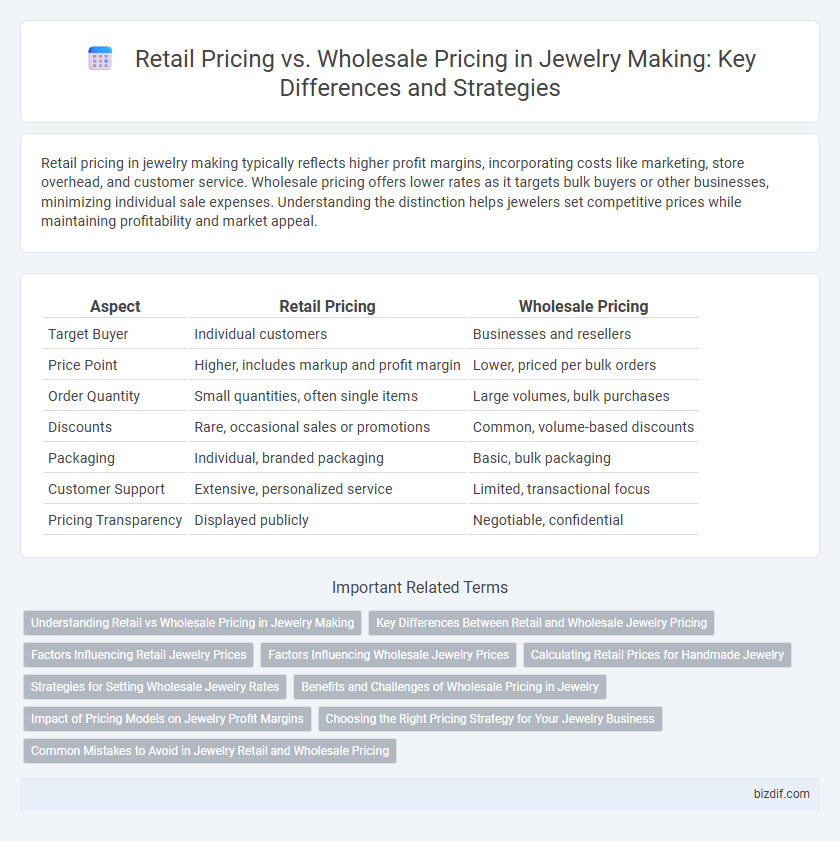Retail pricing in jewelry making typically reflects higher profit margins, incorporating costs like marketing, store overhead, and customer service. Wholesale pricing offers lower rates as it targets bulk buyers or other businesses, minimizing individual sale expenses. Understanding the distinction helps jewelers set competitive prices while maintaining profitability and market appeal.
Table of Comparison
| Aspect | Retail Pricing | Wholesale Pricing |
|---|---|---|
| Target Buyer | Individual customers | Businesses and resellers |
| Price Point | Higher, includes markup and profit margin | Lower, priced per bulk orders |
| Order Quantity | Small quantities, often single items | Large volumes, bulk purchases |
| Discounts | Rare, occasional sales or promotions | Common, volume-based discounts |
| Packaging | Individual, branded packaging | Basic, bulk packaging |
| Customer Support | Extensive, personalized service | Limited, transactional focus |
| Pricing Transparency | Displayed publicly | Negotiable, confidential |
Understanding Retail vs Wholesale Pricing in Jewelry Making
Retail pricing in jewelry making typically includes the cost of materials, labor, overhead, and a profit margin, resulting in a higher price per piece compared to wholesale pricing. Wholesale pricing is designed for bulk purchases, offering discounts to retailers who buy larger quantities, thereby reducing the per-unit cost. Understanding the balance between retail and wholesale pricing ensures jewelry makers can set competitive prices that cover costs and maximize profitability while appealing to different market segments.
Key Differences Between Retail and Wholesale Jewelry Pricing
Retail jewelry pricing typically involves higher markups to cover store expenses, marketing, and customer service, resulting in prices that reflect the end consumer's cost. Wholesale jewelry pricing focuses on bulk purchases with lower per-unit costs, aimed at businesses or resellers who buy directly from manufacturers or distributors. Key differences include volume discounts, payment terms, and pricing transparency, where wholesale offers competitive rates but usually requires larger order commitments compared to retail's single-item purchases.
Factors Influencing Retail Jewelry Prices
Retail jewelry prices are influenced by factors such as brand reputation, craftsmanship, gemstone quality, and store overhead costs, including marketing and retail space expenses. Wholesale pricing typically reflects bulk purchase discounts, lower per-unit costs, and reduced marketing expenses, enabling jewelers to offer more competitive rates. Consumer demand, market trends, and metal prices like gold and silver also play significant roles in determining retail versus wholesale jewelry pricing.
Factors Influencing Wholesale Jewelry Prices
Wholesale jewelry prices are primarily influenced by factors such as material costs, including precious metals and gemstones, labor expenses, production scale, and supplier relationships. Market demand fluctuations and the complexity of design also impact wholesale pricing structures. Understanding these elements helps retailers set competitive retail prices while maintaining healthy profit margins.
Calculating Retail Prices for Handmade Jewelry
Calculating retail prices for handmade jewelry involves factoring in material costs, labor time, and overhead expenses to ensure profitability beyond wholesale pricing. Retail prices typically include a markup of 2 to 3 times the total cost, reflecting the value of craftsmanship and uniqueness. Accurate pricing strategies balance competitive market rates with fair compensation for artisanal skills and quality.
Strategies for Setting Wholesale Jewelry Rates
Wholesale jewelry pricing strategies prioritize volume sales by offering significant discounts compared to retail prices, typically ranging from 30% to 50% off retail value. Setting wholesale rates involves analyzing production costs, market demand, competitor pricing, and desired profit margins to ensure sustainability and attractiveness for bulk buyers. Strategic tiered pricing and minimum order quantities can optimize profitability while encouraging larger purchases from retailers and distributors.
Benefits and Challenges of Wholesale Pricing in Jewelry
Wholesale pricing in jewelry offers significant benefits such as lower cost per unit, enabling retailers to maximize profit margins and maintain competitive retail pricing. Challenges include managing bulk inventory, ensuring consistent quality across large orders, and navigating complex supplier relationships that may impact delivery timelines. This pricing strategy supports scalability but requires robust inventory and quality control systems to avoid financial risks.
Impact of Pricing Models on Jewelry Profit Margins
Retail pricing in jewelry typically incorporates higher markups to cover operating expenses and brand positioning, resulting in greater profit margins per piece. Wholesale pricing offers lower margins due to bulk sales but compensates with higher volume, making it attractive for large-scale distribution. The choice between these pricing models directly influences jewelry profit margins by balancing unit profitability against sales velocity and market reach.
Choosing the Right Pricing Strategy for Your Jewelry Business
Setting the right pricing strategy in jewelry making involves balancing retail pricing, which reflects the final consumer cost and brand value, against wholesale pricing that appeals to bulk buyers and retailers. Effective pricing takes into account material costs, craftsmanship, market demand, and competitor rates to maximize profit margins while maintaining customer appeal. Understanding the difference between retail and wholesale pricing ensures sustainable growth and positioning within the competitive jewelry industry.
Common Mistakes to Avoid in Jewelry Retail and Wholesale Pricing
Setting retail and wholesale prices without thorough market research often leads to undervaluing jewelry, impacting profitability. Ignoring material costs, labor, and overhead expenses results in pricing that fails to cover production costs, causing financial losses. Overlooking competitor pricing and failing to account for perceived customer value frequently hinders sales and brand positioning in the jewelry market.
Retail pricing vs Wholesale pricing Infographic

 bizdif.com
bizdif.com